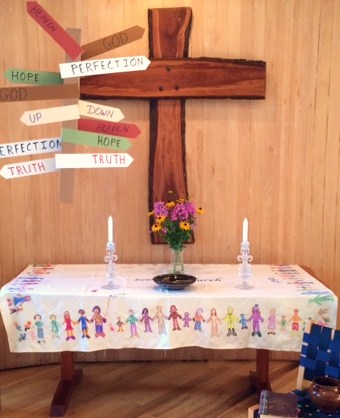“Certainty and Truth” by David Lloyd
August 23, 2015
Thirteenth Sunday after Pentecost
When Kevin preached two weeks ago I was struck by his voicing the forlorn hope that our Celebration Circle mission group would explain its choice of our liturgical theme “Missing the Point.” I don’t expect Celebration Circle to explain its theme, but the theme, the reflection statement that “Certainty is missing the point entirely,” and the confusing signpost that is both at the altar and on the cover of our worship folder have all been challenging me these weeks.
Some details in scripture are clearly verifiable. There is a city called Jerusalem and the towns of Bethlehem and Nazareth. But some parts of scripture presented as historical narrative are not verifiable. The books of Kings and Chronicles have details about both Hebrew and Gentile leaders and wars that conflict with details unearthed in archeology. Details in the book of Daniel aren’t verifiable because they are mystical or metaphorical; Ezekiel and Isaiah contain unverifiable ecstatic prophecy.
Misquoting Jesus. We only have translations that are based on centuries of copying a selection of Latin and Greek texts made in the 3rd century by believers from a range of copies of texts that themselves were a combination of the oral and written traditions of 1st and 2nd century believers who spoke Aramaic, Hebrew and Greek. We know that in the first few centuries of the Church different Christian congregations throughout the Mediterranean and Near East used scriptures that frequently varied in details and frequently included and excluded texts of other congregations. We all know that errors creep in when copies are made by hand and many of these copies of scripture made over the centuries in Greek or Latin show “editors’ corrections” in the margins. Ehrman points out that we don’t know whether some of the purported corrections are more accurate than the text they are correcting.
“Doubt isn’t the opposite of faith; it is an element of faith.” And this brings me to where I part company a bit with Anne Lamott. The reflection in our worship folder lifted from her book, Plan B: Further Thoughts on Faith. It sits in a larger context:
I have a lot of faith. But I am also afraid a lot, and have no real certainty about anything. I remembered something Father Tom had told me–that the opposite of faith is not doubt, but certainty. Certainty is missing the point entirely. Faith includes noticing the mess, the emptiness and discomfort, and letting it be there until some light returns.
I agree with her that “faith includes noticing the mess, the emptiness and discomfort, and letting it be there until some light returns.” I think that is what Mother Teresa experienced when she felt the absence of God for so long.
But Mother Teresa continued praying because she had faith; she believed that there is a truthfulness of Christianity, perhaps believed it to the point of certainty. The history of Christianity is that not just hundreds of thousands, but hundreds of millions, have had faith despite some doubts, have believed the truthfulness of Christianity. And what is that truthfulness?